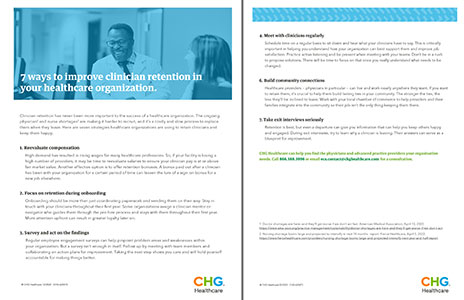
Clinician burnout combined with a fiercely competitive labor market has led to a perfect storm for the healthcare industry. A CHG Healthcare survey found that 43% of physicians changed jobs and another 8% retired during the pandemic. Meanwhile, Medscape reports that 20% of physicians have thought about leaving medicine to pursue nonclinical careers, and 19% changed jobs as a way to cope with burnout.
“We’re feeling that pain right now,” says Tarese Dubiel, director of physician and APC recruitment and onboarding for Marshfield Clinic Health System. The organization, like most healthcare systems, has many providers nearing retirement. “Three years ago, they'd work into their 70s — sometimes 80s — because they just weren't ready to hang up the white coat yet. Now, as soon as they hit 65 or even before that they're saying ‘I don't want to do this anymore; this is hard. I don't want to put myself at risk and the work is a lot different than it was two years ago.’”
But even amidst the turmoil, healthcare systems are finding new ways to hold onto providers. Here are seven ways Marshfield Clinic Health System and six other healthcare organizations are working to retain providers and keep them happy.
1. Reevaluate provider compensation
High demand has caused wages to increase for many healthcare professions. If your facility is losing a high number of providers, it may be time to reevaluate salaries.
“We are looking at salaries and making sure that everyone is within or above a fair market value,” says Amy Burns, manager of physician recruitment for Ascension St. Vincent’s. Additionally, Ascension is fighting back against the lure of sign-on bonuses with retention bonuses of their own. “You might get a bonus when you start, and then if you stick around for a year, you get another bonus,” she says. “We are working toward making sure that we are competitive so that people don't want to leave for a few dollars more somewhere else.”
“We are offering incentives to providers that I’ve never seen in the past,” says Amber Latham, HR recruiter at Presbyterian Healthcare Services. “We want to meet their need and make sure they’re going to be happy in choosing our facility and want to stay. We’ve offered bonuses and raises, so we’re definitely trying to keep up with some of the competitors within our region.”
2. Make retention a focus of onboarding
Parkview Health focuses on retention from the moment a provider joins the organization. Onboarding is “more than coordinating scores of paperwork and sending them on their way,” says Angela Pulcini, director of provider services for Parkview Health. “It's staying in touch with our providers throughout their first year. They have a physician mentor assigned to them as well as a navigator who guides them through the pre-hire process and then stays with them throughout the first year.”
3. Survey providers and take action on the results
Provider engagement surveys can help you pinpoint problem areas. But surveys are just the first step for Marshfield Clinic Health System. “Our leaders are expected to meet with our teams and provide action plans back to our one-up manager,” Dubiel says. “So, I have to go to my team and say, ‘Here's our results; here's the things we should be working on to improve.’ And then, ‘How do we take that up to the next step to show we're going to be accountable to improving those things.’”
4. Facilitate meetings between providers and senior leaders
Senior leaders at Mercy meet directly with physicians to ask them what they need. “It starts with listening and being present,” says Barb Martin, director, ambulatory care recruitment. “Our senior leadership team sets intentional time to sit down and listen to what providers have to say. This is critically important in understanding how we may best support them to improve engagement, satisfaction, and reduce burnout.”
5. Focus on meaningful communication
The pandemic changed the way many healthcare organizations communicate with providers as they struggled to roll out new policies and procedures. Good communication with providers is just as important post-pandemic.
Marshfield Clinic Health System strives to make sure providers are aware of positive things happening within the organization. “For many years we were doing really cool things, but we weren't telling people about it,” Dubiel says. For example, Marshfield was an early leader in telemedicine, and they grew their organization from one hospital to 10 in five years. “We just didn’t tell anybody about it,” she says.
“Now we're doing weekly email updates from our CEO to all staff and providers across our system highlighting the things we're doing,” Dubiel says. “It's never fun when employees or providers are hearing about the cool things we're doing on the news — they want to hear it from our leaders internally first, so we're getting a lot better at that.”
6. Help providers and their families build community connections
Healthcare providers — and physicians in particular — can live and work nearly anywhere they want. If you want to retain them, it’s crucial to help providers build lasting ties within the community so they will be less inclined to leave.
“We work with our chamber of commerce, which has great programs to help people get integrated in their community. When family, partners, and spouses find opportunities within our community, their job is not the only thing keeping them here,” explains Jessie Pondell, manager of talent strategy for Prevea Health.
That effort to foster community connections begins during the recruitment process for Aspirus Health. “It’s just letting them know right up front that we have amazing resources — anything that they need, they can reach out to us,” says Nicole Kiser, locum tenens recruiter for Aspirus Health. "We literally have resources for everything in the community: daycare, making sure your family is a good fit, if you need help with this and that. Providing as many possible resources as you can upfront during the recruitment process — that's really something that sticks with them.”
7. Take exit interviews seriously
Exit interviews can help provide a blueprint for improvement. “During those exit interviews or even during that time of receiving that resignation, we’re trying to see what, overall, the reason they’re leaving is and what can Presbyterian do better,” Latham says.
Provider retention is a major challenge for nearly every health system, but following these strategies can help improve provider satisfaction and increase loyalty to your organization.

CHG can provide your healthcare facility with the physicians and advanced practice providers you need to grow your organization. To learn more, contact us by phone at 866.588.5996 or email ecs.contact@chghealthcare.com.